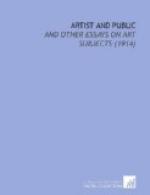Of the art of music I must speak with the diffidence becoming to the ignorant; but it seems to me to consist of two elements and to contain an inspirational art as direct and as simple as that of poetry, and a science so difficult that its fullest mastery is of very recent achievement. In melodic invention it is so far from progressive that its most brilliant masters are often content to elaborate and to decorate a theme old enough to have no history—a theme the inventor of which has been so entirely forgotten that we think of it as sprung not from the mind of one man, but from that of a whole people, and call it a folk-song. The song is almost as old as the race, but the symphony has had to wait for the invention of many instruments and for a mastery of the laws of harmony, and so symphonic music is a modern art. We are still adding new instruments to the orchestra and admitting to our compositions new combinations of sounds, but have we in a hundred years made any essential progress even in this part of the art? Have we produced anything, I will not say greater, but anything as great as the noblest works of Bach and Beethoven?
Already, and before considering the arts of painting and sculpture, we are coming within sight of our general law. This law seems to be that, so far as an art is dependent upon any form of exact knowledge, so far it partakes of the nature of science and is capable of progress. So far as it is expressive of a mind and soul, its greatness is dependent upon the greatness of that mind and soul, and it is incapable of progress. It may even be the reverse of progressive, because as an art becomes more complicated and makes ever greater demands upon technical mastery, it becomes more difficult as a medium of expression, while the mind to be expressed becomes more sophisticated and less easy of expression in any medium. It would take a greater mind than Homer’s to express modern ideas in modern verse with Homer’s serene perfection; it would take, perhaps, a greater mind than Bach’s to employ all the resources of modern music with his glorious ease and directness. And greater minds than those of Bach and Homer the world has not often the felicity to possess.
The arts of painting and sculpture are imitative arts above all others, and therefore more dependent than any others upon exact knowledge, more tinged with the quality of science. Let us see how they illustrate our supposed law.




